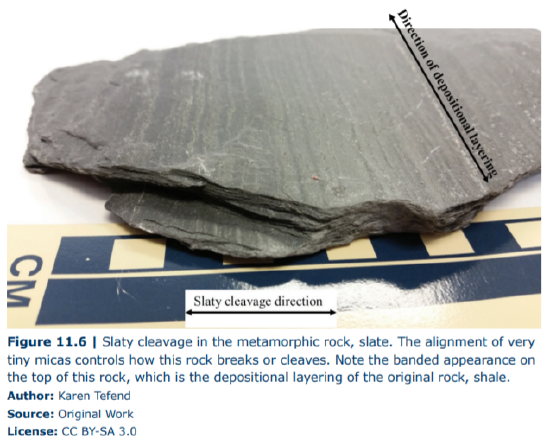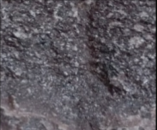11.3: Metamorphic Rock Names
- Page ID
- 5665
\( \newcommand{\vecs}[1]{\overset { \scriptstyle \rightharpoonup} {\mathbf{#1}} } \)
\( \newcommand{\vecd}[1]{\overset{-\!-\!\rightharpoonup}{\vphantom{a}\smash {#1}}} \)
\( \newcommand{\id}{\mathrm{id}}\) \( \newcommand{\Span}{\mathrm{span}}\)
( \newcommand{\kernel}{\mathrm{null}\,}\) \( \newcommand{\range}{\mathrm{range}\,}\)
\( \newcommand{\RealPart}{\mathrm{Re}}\) \( \newcommand{\ImaginaryPart}{\mathrm{Im}}\)
\( \newcommand{\Argument}{\mathrm{Arg}}\) \( \newcommand{\norm}[1]{\| #1 \|}\)
\( \newcommand{\inner}[2]{\langle #1, #2 \rangle}\)
\( \newcommand{\Span}{\mathrm{span}}\)
\( \newcommand{\id}{\mathrm{id}}\)
\( \newcommand{\Span}{\mathrm{span}}\)
\( \newcommand{\kernel}{\mathrm{null}\,}\)
\( \newcommand{\range}{\mathrm{range}\,}\)
\( \newcommand{\RealPart}{\mathrm{Re}}\)
\( \newcommand{\ImaginaryPart}{\mathrm{Im}}\)
\( \newcommand{\Argument}{\mathrm{Arg}}\)
\( \newcommand{\norm}[1]{\| #1 \|}\)
\( \newcommand{\inner}[2]{\langle #1, #2 \rangle}\)
\( \newcommand{\Span}{\mathrm{span}}\) \( \newcommand{\AA}{\unicode[.8,0]{x212B}}\)
\( \newcommand{\vectorA}[1]{\vec{#1}} % arrow\)
\( \newcommand{\vectorAt}[1]{\vec{\text{#1}}} % arrow\)
\( \newcommand{\vectorB}[1]{\overset { \scriptstyle \rightharpoonup} {\mathbf{#1}} } \)
\( \newcommand{\vectorC}[1]{\textbf{#1}} \)
\( \newcommand{\vectorD}[1]{\overrightarrow{#1}} \)
\( \newcommand{\vectorDt}[1]{\overrightarrow{\text{#1}}} \)
\( \newcommand{\vectE}[1]{\overset{-\!-\!\rightharpoonup}{\vphantom{a}\smash{\mathbf {#1}}}} \)
\( \newcommand{\vecs}[1]{\overset { \scriptstyle \rightharpoonup} {\mathbf{#1}} } \)
\( \newcommand{\vecd}[1]{\overset{-\!-\!\rightharpoonup}{\vphantom{a}\smash {#1}}} \)
\(\newcommand{\avec}{\mathbf a}\) \(\newcommand{\bvec}{\mathbf b}\) \(\newcommand{\cvec}{\mathbf c}\) \(\newcommand{\dvec}{\mathbf d}\) \(\newcommand{\dtil}{\widetilde{\mathbf d}}\) \(\newcommand{\evec}{\mathbf e}\) \(\newcommand{\fvec}{\mathbf f}\) \(\newcommand{\nvec}{\mathbf n}\) \(\newcommand{\pvec}{\mathbf p}\) \(\newcommand{\qvec}{\mathbf q}\) \(\newcommand{\svec}{\mathbf s}\) \(\newcommand{\tvec}{\mathbf t}\) \(\newcommand{\uvec}{\mathbf u}\) \(\newcommand{\vvec}{\mathbf v}\) \(\newcommand{\wvec}{\mathbf w}\) \(\newcommand{\xvec}{\mathbf x}\) \(\newcommand{\yvec}{\mathbf y}\) \(\newcommand{\zvec}{\mathbf z}\) \(\newcommand{\rvec}{\mathbf r}\) \(\newcommand{\mvec}{\mathbf m}\) \(\newcommand{\zerovec}{\mathbf 0}\) \(\newcommand{\onevec}{\mathbf 1}\) \(\newcommand{\real}{\mathbb R}\) \(\newcommand{\twovec}[2]{\left[\begin{array}{r}#1 \\ #2 \end{array}\right]}\) \(\newcommand{\ctwovec}[2]{\left[\begin{array}{c}#1 \\ #2 \end{array}\right]}\) \(\newcommand{\threevec}[3]{\left[\begin{array}{r}#1 \\ #2 \\ #3 \end{array}\right]}\) \(\newcommand{\cthreevec}[3]{\left[\begin{array}{c}#1 \\ #2 \\ #3 \end{array}\right]}\) \(\newcommand{\fourvec}[4]{\left[\begin{array}{r}#1 \\ #2 \\ #3 \\ #4 \end{array}\right]}\) \(\newcommand{\cfourvec}[4]{\left[\begin{array}{c}#1 \\ #2 \\ #3 \\ #4 \end{array}\right]}\) \(\newcommand{\fivevec}[5]{\left[\begin{array}{r}#1 \\ #2 \\ #3 \\ #4 \\ #5 \\ \end{array}\right]}\) \(\newcommand{\cfivevec}[5]{\left[\begin{array}{c}#1 \\ #2 \\ #3 \\ #4 \\ #5 \\ \end{array}\right]}\) \(\newcommand{\mattwo}[4]{\left[\begin{array}{rr}#1 \amp #2 \\ #3 \amp #4 \\ \end{array}\right]}\) \(\newcommand{\laspan}[1]{\text{Span}\{#1\}}\) \(\newcommand{\bcal}{\cal B}\) \(\newcommand{\ccal}{\cal C}\) \(\newcommand{\scal}{\cal S}\) \(\newcommand{\wcal}{\cal W}\) \(\newcommand{\ecal}{\cal E}\) \(\newcommand{\coords}[2]{\left\{#1\right\}_{#2}}\) \(\newcommand{\gray}[1]{\color{gray}{#1}}\) \(\newcommand{\lgray}[1]{\color{lightgray}{#1}}\) \(\newcommand{\rank}{\operatorname{rank}}\) \(\newcommand{\row}{\text{Row}}\) \(\newcommand{\col}{\text{Col}}\) \(\renewcommand{\row}{\text{Row}}\) \(\newcommand{\nul}{\text{Nul}}\) \(\newcommand{\var}{\text{Var}}\) \(\newcommand{\corr}{\text{corr}}\) \(\newcommand{\len}[1]{\left|#1\right|}\) \(\newcommand{\bbar}{\overline{\bvec}}\) \(\newcommand{\bhat}{\widehat{\bvec}}\) \(\newcommand{\bperp}{\bvec^\perp}\) \(\newcommand{\xhat}{\widehat{\xvec}}\) \(\newcommand{\vhat}{\widehat{\vvec}}\) \(\newcommand{\uhat}{\widehat{\uvec}}\) \(\newcommand{\what}{\widehat{\wvec}}\) \(\newcommand{\Sighat}{\widehat{\Sigma}}\) \(\newcommand{\lt}{<}\) \(\newcommand{\gt}{>}\) \(\newcommand{\amp}{&}\) \(\definecolor{fillinmathshade}{gray}{0.9}\)Foliated Metamorphic Rocks
As mentioned previously, differential pressures can cause a foliation to develop in metamorphosed rocks. There are a few types of foliations that are commonly seen in metamorphic rocks, each foliation type is dependent on the minerals that define the foliation. One type is described as a layering of dark and light-colored minerals so that the foliation is defined as alternating dark and light mineral bands throughout the rock. Such a foliation is called gneissic banding (Figure 11.3), and the metamorphic rock is called gneiss (pronounced “nice”, with a silent g). In Figure 11.3A, the layering in this gneiss is horizontal, and the greatest pressures were at right angles to the gneissic bands. Note that these bands are not always flat, but may be seen contorted as in Figure 11.3B; this rock still is considered to have gneissic banding even though the bands are not horizontal. The typical minerals seen in the dark-colored bands are biotite micas and/or amphiboles, whereas the light-colored bands are typically quartz or light-colored feldspars. The protoliths for gneiss can be any rock that contains more than one mineral, such as shale with its clay minerals and clay-sized quartz and feldspar, or an igneous rock with both dark-colored ferromagnesian minerals and light-colored non-ferromagnesian minerals (see Chapter 8 for review). In order for gneissic foliation to develop, temperatures and pressures need to be quite high; for this reason, gneiss rocks represent a high grade of metamorphism.

Sometimes a metamorphic rock is seen with mostly amphibole minerals that can define a foliation pattern as well and is called an amphibolite (Figure 11.4). Occasionally amphibolites also have layers of light-colored plagioclase minerals present; in that case, the rock may be called an amphibole gneiss. Amphibolites may not always have a foliation. However, the rock picture in Figure 11.4 appears to have a parallel alignment of the amphiboles (see red arrows in the figure), making this a foliated amphibolite. The protolith for an amphibolite must be a rock type with a large amount of dark ferromagnesian minerals, such as a mafic or ultramafic igneous rock. Amphibolites require higher temperatures and pressures to form as well and are considered to be high-grade metamorphic rocks.

Another type of foliation is defined by the presence of flat or platy minerals, such as muscovite or biotite micas. Metamorphic rocks with a foliation pattern defined by the layering of platy minerals are called schist; the rock name is commonly modified to indicate what mica is present. For example, Figure 11.5 is a photo of muscovite schist. However, it also has garnet present, so the correct name for the rock pictured in Figure 11.5 is garnet muscovite schist. By convention, when naming a metamorphic rock the mineral in the lowest quantity (garnet, in this case) is mentioned first. Notice that the muscovite micas define a very wavy foliation in the rock; this textural pattern of wavy micas is called a schistose foliation (Figure 11.5B). The sedimentary rock shale is usually the protolith for schist; during metamorphism, the very tiny clay minerals in shale recrystallize into micas that are large enough to see unaided. Temperatures and pressures necessary for schistose foliation are not as high as those for gneiss and amphibolite; therefore schists represent an intermediate grade of metamorphism.

There is one foliation type that is defined by the alignment of minerals that are too small to see, yet the foliation can still be visible. This type of foliation is only seen in the metamorphic rock called slate; slate forms by the low temperature and low-pressure alteration of a shale protolith. The clay-sized minerals in the shale recrystallize into very tiny micas which are larger than the clay minerals, but still too small to be visible. However, because these tiny micas are aligned, they control how the metamorphic rock (slate) breaks, and the rock tends to break parallel to the mica alignment. Therefore, even though we cannot see the aligned minerals that define the foliation, we can use the alignment of the rock fracture pattern, as the rock is cleaved or split. For this reason, the foliation is called a slaty cleavage, and a rock displaying this type of foliation is called a slate. Figure 11.6 is an example of the foliated slate displaying slaty cleavage; notice that this rock has retained its original sedimentary layering (depositional beds), which in this case is quite different from the foliation direction. The only protolith for slate is shale, and the fact that original sedimentary features and even some fossils in shale may be preserved and visible in slate is due to the low temperatures and pressures that barely alter the shale protolith, making slate an example of a low-grade metamorphic rock. Slate has great economic value in the construction industry; due to its ability to break into thin layers and impermeability to water, slate is used as roofing tiles and flooring.

Non-Foliated Metamorphic Rocks
The other class of metamorphic rocks is non-foliated; the lack of foliation may be due to a lack of differential pressure involved in the metamorphic process. However, this is not necessarily the case for all non-foliated metamorphic rocks. If the protolith rock is monominerallic (composed of one mineral type), such as limestone, dolostone, or sandstone with only quartz sands, then a foliation will not develop even with differential pressure. Why? The calcite mineral in limestone, the dolomite mineral in dolostone, and the quartz sands in sandstone are neither platy minerals, nor are there different colored minerals in these rocks. These minerals (calcite, dolomite, and quartz) recrystallize into equigranular, coarse crystals (see Figure 11.2B), and the metamorphic rocks that they make are named by their composition, not by foliation type. For example, Figure 11.7 is quartzite, a metamorphosed quartz-rich sandstone. Figure 11.8 shows two examples of marble; note that color can vary for marble, as well as for the quartzite. As a result, quartzites and marbles may be hard to identify based on appearance, therefore you must rely on the properties of the minerals that comprise these rocks; you may recall that quartz is harder than glass, while limestone and dolomite are softer than glass. Also, marble will react (effervesce) to acid, but quartz will not react. If you zoom in for a close view of the marble in Figure 11.8, you will see the calcite crystals are fairly large compared to the quartz crystals in the quartzite in Figure 11.7; this can be attributed to the temperature of metamorphism, as higher temperatures result in larger crystals. These rocks are also of economic importance; marble and quartzite are used for dimension stone in buildings and for countertops in many homes. Furthermore, marble is commonly used for statues and sometimes grave markers.

One final non-foliated rock type that should be mentioned is anthracite coal (Figure 11.9). As you may recall, coal is a sedimentary rock composed of fossilized plant remains. This sedimentary coal is called bituminous coal; under higher temperatures and pressures bituminous coal can lose more of the volatiles typical of coal (water vapor, for example), but the carbon content is enriched, making metamorphic coal (anthracite coal) a hotter burning coal due to the higher carbon content. Anthracite coal can be distinguished from sedimentary coal by the shinier appearance, and is somewhat harder than bituminous coal, although both coal types are of low density due to their carbon content. Note that this particular metamorphism is not a recrystallization event, per se, as coal is mostly organic remains. However, bonds are still being broken and reforming due to changes in temperature and pressure.
In order to identify and name metamorphic rocks, a logical first step would be to examine the rock for evidence of any pattern or foliation, and if present, identify what mineral or minerals are making the foliation pattern. Non-foliated metamorphic rocks can be identified by the properties defined by their mineral composition. Below is a table summarizing the metamorphic rock types, foliation names, and protolith rock types (Table 11.1).

| Table 11.1: Summary Chart of Metamorphic Rocks Discussed in this Chapter | |||||
| Texture | Characteristics | Protolith | Metamorphic Rock Name | ||
|
Foliated (Increasing Temperature and Pressure Going Down the Table) |
Fine-grained rock that tends to split in parallel fragments (known as slaty cleavage). | Shale | Slate |  |
|
| Contains shiny muscovite (light) or biotite (dark) micas, may see other minerals. Has schistose pattern of foliation. | Shale | Schist |  |
||
| Contains alternating bands of light and dark-colored minerals (usually biotite or amphibole), called gneissic banding. | Shale of Igneous Rock | Gneiss |  |
||
|
Possibly Foliated |
Most of the minerals in this rock are amphiboles, which may be aligned to form a foliation. | Mafic or Ultramafic Rock | Amphibolite |  |
|
|
Non-foliated |
Equigranular grains of quartz which has a hardness of 7. | Sandstone or Siltstone | Quartzite |  |
|
| Equigranular grains of calcite or dolomite, which has a hardness of 4, and reacts to acid. | Limestone or Dolostone | Marble |  |
||
| Contains mostly carbon, is a low-density rock, and has a shiny appearance. | Bituminous Coal | Anthracite Coal |  |
||


